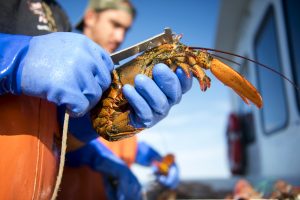Equipment


In addition to the boat and the traps, there are various smaller pieces of equipment or gear regularly used by lobstermen.
- Bait Bag: Originally made of cotton twine, and now typically made of nylon mesh, the bait bag is stuffed with the lobsterman’s bait of choice (typically herring) and hung inside the trap to entice lobsters to enter. (Some bait bags used today are truly not even “bags” but rather perforated molded plastic containers.)
- Banding Tool: The implement used to put the rubber bands on the lobster’s claws.
- Buoy: A floating device, the buoy is used to mark the location where a lobsterman has dropped his trap or trawl. Each lobsterman registers and uses the same color scheme on all of his or her buoys to differentiate them from the other lobstermen’s.
- Gaff Hook: Tool used to snare a buoy and pull the attached warp or line up to the pot hauler.
- Gauge: A measuring devise used by lobstermen to determine if a lobster meets the minimum and maximum regulations for a legal catch in those areas required. One side of the gauge measures the minimum and the other the maximum .
- Pot Hauler: An hydraulic winch attached to the side of a lobster boat that is used to pull the traps out of the water.
- Trap Warp: The rope or line used to connect traps to buoys and traps to traps in the case of a trawl.
- V-Notch Tool: The implement used to make a v-shaped cutout in the tailfin (just right of center) of the lobster. The v-notch identifies female lobsters that are capable of bearing eggs. Many areas require all egg-bearing females caught in traps be v-notched and released, and any lobster bearing a v-notch is not legal to keep. Releasing v-notched lobsters is a method used to conserve the brood stock.
Click here to see and learn more about lobstering equipment.
